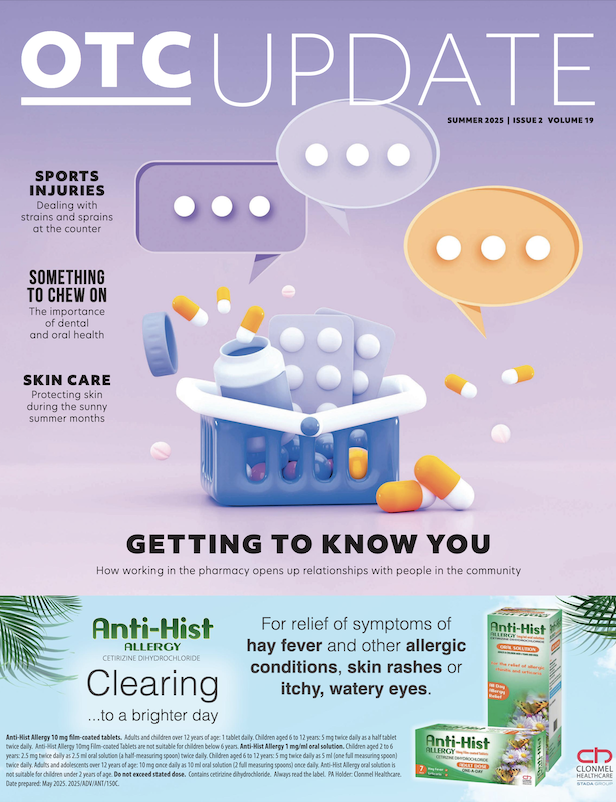Damien O’Brien MPSI provides a clinical overview of assessment and treatment for allergic rhinitis
Introduction
Allergic rhinitis (AR) is an atopic disease characterised by symptoms of sneezing, nasal congestion, rhinorrhoea, itching, and postnasal drip. AR is an inflammatory condition of the nasal mucosa that can range from mild nasal congestion, to severe allergic responses.
It can be classified into seasonal allergic rhinitis and perennial allergic rhinitis. Seasonal allergic rhinitis, also known as hay fever, is triggered by pollen and is particularly common during spring and summer. Perennial allergic rhinitis is present all year and may be triggered by exposure to allergens such as
dust mites, animal dander, and mold spores. Pharmacists are often the first point of contact for patients with AR, and they play an important role in providing advice on both pharmacological and non- pharmacological treatment options.1
The prevalence of AR based on clinical diagnosis is approximately 15 per cent, but it may be double that based on patients experiencing symptoms. AR was previously thought to be a condition of the nasal passage, but it is now considered a systemic allergic response and is associated with conditions such as atopic dermatitis and asthma.
Symptoms can vary widely in severity and may be classified into nasal, ocular and systemic symptoms. Nasal symptoms may include sneezing, congestion, rhinorrhoea, itching and postnasal drip. Ocular symptoms include itchy, watery and red eyes, with associated allergic conjunctivitis also possible. Fatigue and headache may also be present as systemic symptoms. AR is associated with significant morbidity, reduced productivity, and increased healthcare costs. Poorly- controlled AR may lead to sinusitis, sleep disturbances and reduced quality of life; however, it is treatable in a variety of ways.1
Background of allergic rhinitis
AR is caused by an immune-mediated response to environmental allergens. When an individual is exposed to an inhaled allergen, the immune system reacts, triggering a cascade of immune reactions.
Firstly, the sensitisation phase occurs upon first exposure to an allergen, leading to production of allergen-specific IgE antibodies by B cells and inflammation in the nasal mucosa. This initial response occurs within five-to-15 minutes of exposure to an antigen. The early-phase reaction consists of the degranulation of mast cells, releasing mediators such as histamine, leukotrienes, and prostaglandins. These mediators, particularly histamine, play a key role in AR, causing symptoms such as nasal congestion, sneezing and rhinorrhoea.
The late-phase reaction occurs four- to-six hours after the initial response, during which inflammatory cells such as eosinophils, basophils and T cells are released. This leads to persistent inflammation and prolonged symptoms.1 Several risk factors contribute to the development of AR. There is a genetic
predisposition to AR, with a family history increasing the risk. Furthermore, a personal history of asthma or eczema also raises the likelihood of developing AR. Exposure to environmental allergens and pollutants may contribute to AR or exacerbate symptoms. Lifestyle factors, including smoking, poor air quality and urban living, may also play a role in symptom severity.1,2
Diagnosis
The diagnosis of allergic rhinitis is typically clinical, based on a thorough history-taking and physical examination. History-taking should focus on the type, timing, duration and frequency of symptoms, as well as suspected triggers, exacerbating factors, alleviating factors, and seasonality. A positive response to treatment can support the diagnosis.
A formal diagnosis may be made using serum testing for allergen-specific IgE or allergy skin testing, but this is usually reserved for patients who are unresponsive to empirical treatment or those who require identification of a specific allergen for targeted treatment. Testing should be carried out during the peak symptom season in patients with seasonal AR.1
Pharmacological treatment
Pharmacological treatment plays a crucial role in the management of AR. The choice of treatment depends on symptom severity, frequency, and patient preference. Pharmacological options include antihistamines, corticosteroids, decongestants, leukotriene receptor antagonists (LTRAs), and immunotherapy, which may be administered orally, intranasally, intraocularly, or via subcutaneous injection. Patients with severe symptoms may benefit from combination therapy rather than monotherapy.1
Antihistamines
Antihistamines are a first-line treatment option for AR. Histamine is one of the primary inflammatory mediators of AR. Antihistamines treat histamine-mediated conditions by acting as antagonists at the H1 receptor, reducing allergy symptoms. Antihistamines are typically administered orally, while intravenous or intramuscular administration is also possible, but is usually reserved for hospital settings for the treatment of specific conditions.
H1 antihistamines can be classified into first- and second-generation agents. First-generation H1 antihistamines cross the blood-brain barrier into the central nervous system, whereas second- generation H1 antihistamines do not. The duration of action of first-generation antihistamines is approximately four- to-six hours, while second-generation antihistamines work for 12-to-24 hours.
There is a broad range of dose- dependent adverse effects associated with antihistamines. Common adverse effects of first-generation H1 receptor antihistamines include sedation, dry mouth, urinary retention, dizziness, tinnitus, and decreased co-ordination. Second- generation antihistamines have a much more favourable adverse effect profile. However, some may be cardiotoxic in certain individuals due to QT-prolonging effects. They also offer ease of use due to their once-daily dosing schedule.1,3
Chlorphenamine is an example of a first-generation antihistamine available over the counter. Second-generation antihistamines available over the counter include fexofenadine, loratadine, and cetirizine, while bilastine and levocetirizine are available on prescription.
Both first- and second-generation antihistamines are effective at controlling symptoms of AR. Second-generation antihistamines exhibit similar efficacy in symptom relief and have favourable safety profiles. Intranasal antihistamines have a rapid onset of action and may be more effective than oral antihistamines in relieving nasal symptoms, as they deliver a higher concentration of medication to the target area. They may be used in combination with intranasal corticosteroids. Common adverse effects include nosebleeds, headache, and nasal irritation.1,3
Ocular allergic symptoms can be treated rapidly with antihistamine eye drops, which directly target ocular tissue and have a better safety profile due to reduced systemic absorption. They can also be used in combination with oral or intranasal agents. Olopatadine and ketotifen are two antihistamines used
in the treatment of ocular symptoms of seasonal allergic conjunctivitis.4
Corticosteroids
Corticosteroids exert their effects by reducing inflammatory cytokine production, mast cell proliferation and cell-mediated immune responses. This results in decreased inflammation in the nasal passages and is effective in alleviating symptoms of AR. However, oral corticosteroids are not recommended as first-line treatment due to their associated adverse effects, including weight gain, abdominal pain, fluid retention, mood alterations, increased risk of osteoporosis, and adrenal insufficiency. In certain cases of severe or refractory symptoms, a short course of systemic corticosteroids may be indicated.1,5
Intranasal corticosteroids are the cornerstone of the pharmacological management of AR. Fluticasone propionate, mometasone furoate, and triamcinolone acetonide are commonly used intranasal corticosteroids. They effectively reduce nasal congestion and inflammation. These agents have an onset of action of approximately 30 minutes, although peak effects may take several hours to days, with maximum benefit achieved after two-to-four weeks of consistent use.
Studies have demonstrated that intranasal corticosteroids are more effective than oral antihistamines in reducing nasal inflammation and are therefore considered first-line treatment for AR. Intranasal corticosteroid therapy can be used as monotherapy or in combination with oral antihistamines.
Common adverse effects include
nasal irritation, nosebleeds and throat irritation. Proper administration of nasal sprays is essential to achieve an optimal clinical response and minimise adverse effects. Additionally, intranasal corticosteroids require regular use for maximum efficacy.1,5
Decongestants
Oral decongestants, such as pseudoephedrine and phenylephrine, are useful in relieving nasal congestion; however, they are not recommended for long-term daily use due to their adverse effect profile. These medications act on adrenergic receptors, resulting in vasoconstriction of the nasal passages and subsequent reduction of inflammation. Adverse effects of decongestants may include insomnia, heart palpitations and increased blood pressure.
Xylometazoline is an alpha-adrenergic agonist used intranasally to cause vasoconstriction and reduce inflammation. However, prolonged use can lead to rebound nasal congestion (rhinitis medicamentosa); therefore, it should not be used for more than one week.1,6
Leukotriene receptor antagonists (LTRAs) LTRAs work by blocking leukotriene receptors, thereby inhibiting the function of these inflammatory mediators. Montelukast is an example of an LTRA used in the treatment of AR. It is administered once daily at night. Although not a first-line treatment for AR, it may be used in combination with other medications for severe or refractory cases. It is particularly beneficial in patients with coexisting asthma. Montelukast is relatively well-tolerated and safe, with the most common adverse effects including headache, abdominal pain, nausea and viral infections.1,7
Immunotherapy
Allergen immunotherapy may be considered in patients where preventive measures and combination pharmacological treatments are ineffective. It is the only treatment that modifies the disease rather than alleviating the symptoms.
Subcutaneous immunotherapy (SCIT) or sublingual immunotherapy (SLIT) are commonly-used approaches. These therapies involve the administration of gradually increasing doses of
the allergen extract until a dose is reached that can effectively induce immunological tolerance. Maintenance doses are typically administered for three-to-five years, providing prolonged and protective effects. The greatest risk associated with immunotherapy is anaphylaxis. However, aside from this risk, allergen immunotherapy has a relatively low incidence of serious adverse effects.1,5
Non-pharmacological treatment
Non-pharmacological strategies play a vital role in the management of AR, particularly when pharmacological treatments are contraindicated or not well-tolerated. They can also be used alongside medications to enhance symptom control.
Nasal irrigation clears allergens from the nasal passages and reduces symptoms. Allergen avoidance should be encouraged to minimise exposure to pollen, animal dander, dust mites and other allergens. Some useful tips to help reduce symptoms of AR are listed below:
- Monitor pollen forecasts and stay indoors during peak counts, keeping windows and doors closed.
- Apply a barrier around the nostrils o trap pollen and other allergens.
- Wear wraparound sunglasses to protect the eyes.
- Shower and change clothes after being outside.
- Use allergen-proof bedding.
- Vacuum-clean the home regularly.
- Avoid pets or groom them regularly.
- Use high-efficiency particulate air (HEPA) filters to trap allergens.
- Avoid smoking and exposure to pollutants.1,8
Role of the pharmacist
AR is a common condition that significantly impacts quality of life. This is particularly relevant in Ireland, where seasonal triggers are common, and pharmacists can play a crucial role in its management.
Pharmacists can educate patients about potential allergens and how to reduce exposure. They can also assess symptom severity and recommend appropriate over-the-counter treatment for patients, considering potential drug interactions and medication adherence.
Counselling patients on proper medication use, including correct nasal spray and eye drop techniques, is an important aspect of a pharmacist’s job. Finally, pharmacists provide accessible healthcare services and collaborate with other healthcare professionals to ensure optimal patient outcomes.
References
1. Akhouri S, and House SA (2023). Allergic rhinitis. [on- line] PubMed.
2. Wang DY (2005). Risk factors of allergic rhinitis: genetic or environmental? Therapeutics and Clinical Risk Management, 1(2), pp.115–123.
3. Farzam K, O’Rourke MC, and Sabir S (2022). Antihistamines. [online] PubMed.
4. Bielory L (2002). Role of anti- histamines in ocular allergy. The American Journal of Medicine, [online] 113(9, Supplement 1), pp.34–37.
5. Sur DK, and Scandale S (2010). Treatment of allergic rhinitis. American Family Physician, [on- line] 81(12), pp.1440–1446.
6. Empey DW, and Medder KT (1981). Nasal Decongestants. Drugs, 21(6), pp.438–443.
7. Choi J, and Azmat CE (2023). Leukotriene Receptor Antago- nists. [online] PubMed.
8. HSE.ie (2024) Hay fever. [on- line] Available at: https://www2. hse.ie/conditions/hay-fever/.







